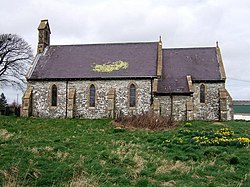Llantood
| Llantood Welsh: Llantwyd | |
| Pembrokeshire | |
|---|---|
 Parish church of St Illtud | |
| Location | |
| Location: | 52°1’60"N, 4°42’0"W |
| Data | |
| Post town: | Cardigan |
| Postcode: | SA43 |
| Dialling code: | 01239 |
| Local Government | |
| Council: | Pembrokeshire |
| Parliamentary constituency: |
Preseli Pembrokeshire |
Llantood (formerly Llantyd, Llantwyd or Llan-Illtyd) is a hamlet and ancient parish in northern Pembrokeshire.
Location
Llantood is three miles south-west of Cardigan on the A487 Cardigan to Newport road near the north Pembrokeshire coast. It consists of a few houses, farms and a parish church on an open hill agricultural area averaging 500 ft above sea level. Nearby settlements include Bridell, Glanrhyd, Monington, Pontgarreg and Tygwyn.
History
Evidence of prehistoric occupation can be seen by the remains of fortifications at Penralltddu, a scheduled monument, and at Castell Felinganol (or Castellfelorganol).[1]
The name of the hamlet is assumed to derive from the 5th-century saint, Illtyd, to whom the parish church is now dedicated. Church records date back to 1674, and the parish was in the Hundred of Kilgerran[2] after being transferred from Cemais in 1542.[3] The region was occupied by the Normans in the 12th century, who built castles at several strategic locations in the area; the clear remains of a motte and bailey exists at Castell Penyrallt (or Castell Pen-yr-allt).[1] A clergyman in 1864 remembered stonework on the latter, but this was no longer evident at the time of the 1925 Royal Commission.[4] The Norman structure may have reused a prehistoric fort.[5]
The name of the parish church was Langetot in the Taxatio of 1293 and as Langettod in the St David's episcopal register of 1513. The attachment to St Illtyd may therefore be of later origin.[4]
In 1870, Llantwyd was listed in Wilson's Gazetteer as consisting of 1,792 acres, 61 houses and a population of 264.[6]
Existing historic buildings
The present parish church of St Illtud dates from 1884, replacing an earlier church of 1820. Stones in the porch suggest there was a church as far back as the 13th century.[1]
Tredefaid is a Grade II listed farmhouse, dating back to the 17th century or earlier. It was originally the home of the Lewes family, and later the Bowen family.[7]
Penralltddu is a Victorian farmhouse built for J. W. Bowen in 1861 on the site of an earlier house dating back at least to 1773.[1]
Sustainable development
A development of six sustainable homes at Glanrhyd was approved by the Pembrokeshire Coast National Park's planning committee in June 2014. The buildings will be manufactured locally and will include free solar powered electricity.[8]
References
- ↑ 1.0 1.1 1.2 1.3 Thomas Lloyd, Julian Orbach, Robert Scourfield (2004). "Pembrokeshire". Yale University Press. p. 258-9.
- ↑ "GENUKI: Llantood". http://www.genuki.org.uk/big/wal/PEM/Llantood/. Retrieved 9 June 2014.
- ↑ Charles, B. G. (1973). "The Second Book of George Owen's "Description of Pembrokeshire"". National Library of Wales Journal, V. p. 265-285.
- ↑ 4.0 4.1 "Royal Commission on the Ancient and Historical Monuments of Wales". H.M. Stationery Office. 1925. p. 180. https://books.google.com/books?id=qcOwIMflx7AC&printsec=frontcover&source=gbs_ge_summary_r&cad=0#v=onepage&q&f=false. Retrieved 9 June 2014.
- ↑ "Dyfed Archaeological Trust". http://www.dyfedarchaeology.org.uk/HLC/lowerteifivalley/crossway.htm. Retrieved 9 June 2014.
- ↑ "A vision of Britain through time - Llantwyd". http://www.visionofbritain.org.uk/place/6639. Retrieved 9 June 2014.
- ↑ "British Listed Buildings". http://www.britishlistedbuildings.co.uk/wa-11978-tredefaid-llantood-cilgerran. Retrieved 9 June 2014.
- ↑ "Sustainable homes go-ahead". Tivyside advertiser. 19 June 2014. http://www.tivysideadvertiser.co.uk/news/11288029.Sustainable_homes_go_ahead/?ref=var_0. Retrieved 19 June 2014.